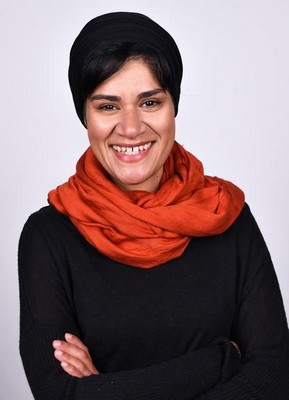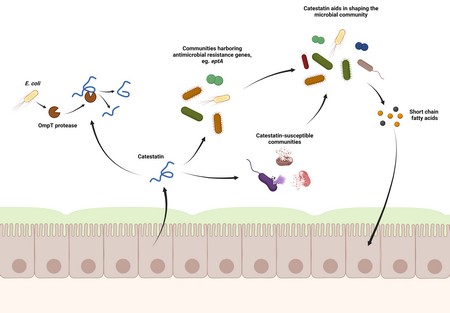Hoe de darmen hun microbensamenstelling regelen
De micro-organismen in onze darmen zijn belangrijk voor onze gezondheid. Welke soorten aanwezig zijn hangt af van verschillende factoren, zoals dieet en gebruik van geneesmiddelen. De binnenste cellaag van de darmen produceert bovendien moleculen die bacteriën kunnen doden. Samen met Amerikaanse collega’s hebben RUG microbioloog Sahar El Aidy en haar groep onderzocht hoe een van die moleculen, catestatine, de soortensamenstelling van micro-organismen in de darm kan beïnvloeden. De resultaten kunnen van belang zijn voor de behandeling van ontstekingsziekten van de darm en zijn gepubliceerd in het tijdschrift ISME (online 19 april).

Micro-organismen in onze darmen produceren allerlei stoffen die een belangrijk effect hebben op de gezondheid, zoals korte-keten vetzuren. Maar het lichaam regelt ook welke bacteriën er in de darm kunnen leven, het zogeheten microbioom. In het epitheel van de darm, de cellaag aan de binnenkant, bevinden zich cellen die verschillende hormoonachtige stoffen produceren. Een daarvan is catestatine, het afbraakproduct van een langer pro-hormoon met de naam chromogranine-A. ‘We weten dat catestatine antimicrobiële eigenschappen heeft, maar dat is voornamelijk vastgesteld via laboratoriumproeven, en in levende organismen is alleen het effect tegen ziekteverwekkers onderzocht’, legt adjunct hoogleraar Sahar El Aidy uit.
Evenwicht
‘Er zijn onderzoeken gepubliceerd die beschrijven dat de concentratie catestatine is veranderd bij patiënten met de (darm)ziekte van Crohn, en dat de stof invloed heeft op overgewicht en verhoogde bloeddruk’, zegt El Aidy. Catestatine lijkt een belangrijke rol te spelen bij de homeostase, het inwendige evenwicht van ons lichaam. Daarom onderzocht zij hoe catestatine het microbioom van de darm kan beïnvloeden.
Daarvoor gebruikten El Aidy en haar groepsleden Markus Schwalbe en Pamela González-Dávila een muismodel dat is ontwikkeld door hun partners van de University of California in San Diego. Dit is een muizenstam die geen catestatine produceert, het gen hiervoor is uitgeschakeld in deze dieren. De zogeheten ‘knock-out’ muizen zijn twee weken behandeld met catestatine. Normale muizen, die dus wel van nature catestatine produceren, kregen dezelfde behandeling. El Aidy: ‘Vervolgens keken we naar functionele veranderingen in het microbioom.’

Behandeling
Hun analyse liet zien na de behandeling een toename van de aanwezighed van een gen van E. coli bacteriën, fosfoethanolamine transferase (eptA), dat zorgt voor de aanmaak van een enzym dat resistentie tegen antimicrobiële middelen veroorzaakt. El Aidy: ‘Bacteriën die gevoelig zijn voor catestatine verdwijnen door de behandeling met deze stof. Onze experimenten laten zien dat catestatine dus inderdaad de soortensamenstelling van de bacteriën in de darm kan veranderen.’ De toename in de activiteit van resistentie-genen was zichtbaar in beide soorten muizen, maar meer uitgesproken in de dieren die zelf geen catestatine aanmaakten. Verdere experimenten lieten zien dat de E. coli bacterie nog een tweede mechanisme heeft dat zorgt voor resistentie, een enzym met de naam omptin dat eiwitten kapot knipt.
‘Deze resultaten helpen ons te begrijpen hoe de soortensamenstelling van bacteriën in de darmen ontstaat’, zegt El Aidy. Bij verschillende ontstekingsziekten van de darm is er een verhoogde hoeveelheid E. coli bacteriën aanwezig en een afwijkende concentratie catestatine. Het lijk erop dat resistente E. coli bacteriën het microbioom zijn gaan domineren. Het vermogen van deze bacteriën om zicht te hechten aan het epitheel van de darmen zou de ontsteking kunnen versterken. Door te laten zien hoe catestatine een rol speelt bij het veranderen van de soortensamenstelling in de darm is een stap gezet in de zoektocht naar de oorzaak en mogelijke behandeling voor darmontstekingen.
Referentie: Pamela González-Dávila*, Markus Schwalbe*, Arpit Danewalia, Boushra Dalile, Kristin Verbeke, Sushil K. Mahata and Sahar El Aidy: Catestatin selects for colonization of antimicrobial-resistant gut bacterial communities. ISME, first online 19 April 2022. *shared first author
Meer nieuws
-
19 december 2025
Mariano Méndez ontvangt Argentijnse RAÍCES-prijs
-
18 december 2025
Waarom innoveren, en voor wie?
-
17 december 2025
Ben Feringa wint Feynmanprijs

